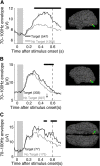Neural dynamics underlying target detection in the human brain
- PMID: 24553944
- PMCID: PMC3931508
- DOI: 10.1523/JNEUROSCI.3781-13.2014
Neural dynamics underlying target detection in the human brain
Abstract
Sensory signals must be interpreted in the context of goals and tasks. To detect a target in an image, the brain compares input signals and goals to elicit the correct behavior. We examined how target detection modulates visual recognition signals by recording intracranial field potential responses from 776 electrodes in 10 epileptic human subjects. We observed reliable differences in the physiological responses to stimuli when a cued target was present versus absent. Goal-related modulation was particularly strong in the inferior temporal and fusiform gyri, two areas important for object recognition. Target modulation started after 250 ms post stimulus, considerably after the onset of visual recognition signals. While broadband signals exhibited increased or decreased power, gamma frequency power showed predominantly increases during target presence. These observations support models where task goals interact with sensory inputs via top-down signals that influence the highest echelons of visual processing after the onset of selective responses.
Keywords: attentional modulation; cognitive neuroscience; extrastriate cortex; human neurophysiology; target detection; visual recognition.
Figures










Similar articles
-
Temporal Dynamics and Response Modulation across the Human Visual System in a Spatial Attention Task: An ECoG Study.J Neurosci. 2019 Jan 9;39(2):333-352. doi: 10.1523/JNEUROSCI.1889-18.2018. Epub 2018 Nov 20. J Neurosci. 2019. PMID: 30459219 Free PMC article.
-
Is that a belt or a snake? Object attentional selection affects the early stages of visual sensory processing.Behav Brain Funct. 2012 Feb 2;8:6. doi: 10.1186/1744-9081-8-6. Behav Brain Funct. 2012. PMID: 22300540 Free PMC article.
-
Task context impacts visual object processing differentially across the cortex.Proc Natl Acad Sci U S A. 2014 Mar 11;111(10):E962-71. doi: 10.1073/pnas.1312567111. Epub 2014 Feb 24. Proc Natl Acad Sci U S A. 2014. PMID: 24567402 Free PMC article.
-
Attention in the real world: toward understanding its neural basis.Trends Cogn Sci. 2014 May;18(5):242-50. doi: 10.1016/j.tics.2014.02.004. Epub 2014 Mar 13. Trends Cogn Sci. 2014. PMID: 24630872 Free PMC article. Review.
-
Infant visual attention and object recognition.Behav Brain Res. 2015 May 15;285:34-43. doi: 10.1016/j.bbr.2015.01.015. Epub 2015 Jan 14. Behav Brain Res. 2015. PMID: 25596333 Free PMC article. Review.
Cited by
-
Hemodynamic functional connectivity optimization of frequency EEG microstates enables attention LSTM framework to classify distinct temporal cortical communications of different cognitive tasks.Brain Inform. 2022 Oct 11;9(1):25. doi: 10.1186/s40708-022-00173-5. Brain Inform. 2022. PMID: 36219346 Free PMC article.
-
Network Anisotropy Trumps Noise for Efficient Object Coding in Macaque Inferior Temporal Cortex.J Neurosci. 2015 Jul 8;35(27):9889-99. doi: 10.1523/JNEUROSCI.4595-14.2015. J Neurosci. 2015. PMID: 26156990 Free PMC article.
-
Correlates of implicit semantic processing as revealed by representational similarity analysis applied to EEG.iScience. 2024 Oct 11;27(11):111149. doi: 10.1016/j.isci.2024.111149. eCollection 2024 Nov 15. iScience. 2024. PMID: 39524349 Free PMC article.
-
Differential Sources for 2 Neural Signatures of Target Detection: An Electrocorticography Study.Cereb Cortex. 2018 Jan 1;28(1):9-20. doi: 10.1093/cercor/bhw343. Cereb Cortex. 2018. PMID: 29253249 Free PMC article.
-
A null model for cortical representations with grandmothers galore.Lang Cogn Neurosci. 2017;32(3):274-285. doi: 10.1080/23273798.2016.1218033. Epub 2016 Aug 9. Lang Cogn Neurosci. 2017. PMID: 29204455 Free PMC article.
References
-
- Allison T, Ginter H, McCarthy G, Nobre AC, Puce A, Luby M, Spencer DD. Face recognition in human extrastriate cortex. J Neurophysiol. 1994;71:821–825. - PubMed
-
- Bansal AK, Vargas-Irwin CE, Truccolo W, Donoghue JP. Relationships among low-frequency local field potentials, spiking activity, and three-dimensional reach and grasp kinematics in primary motor and ventral premotor cortices. J Neurophysiol. 2011;105:1603–1619. doi: 10.1152/jn.00532.2010. - DOI - PMC - PubMed
Publication types
MeSH terms
LinkOut - more resources
Full Text Sources
Other Literature Sources
